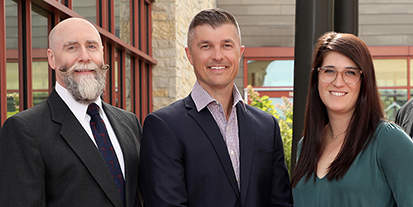
Hernia Surgery

When any kind of pain or unusual bulge occurs in your groin, abdomen, or surrounding areas, it can be concerning — and maybe even a little embarrassing. You might be tempted to put off seeking medical attention due to apprehension or discomfort over talking with a healthcare provider. But ignoring your symptoms may make matters worse, especially if it’s a hernia. Also, there’s nothing to be embarrassed about. Many people get hernias, with hernia repair being one of the most common surgical operations worldwide.
Each type of hernia causes its own distinct symptoms. Often, people struggle knowing the difference between a hernia and a pulled groin muscle, so it’s important to see a doctor to confirm the cause of your discomfort. Left untreated, some hernias can cause severe symptoms and require emergency treatment.
What is a Hernia?
Hernias are a fairly common cause of groin and abdominal pain in people of all ages, from newborns to elderly patients. A hernia occurs when an organ or fatty tissue squeezes through a weak spot in a surrounding muscle or connective tissue called fascia. In men, a cord that brings blood supply to the testicles exits through the abdominal wall, creating a natural weakness. This puts men at a much higher risk than women for hernias.
Hernia Causes
Hernias are caused by a combination of pressure and an opening or weakness of muscle or fascia. Sometimes the muscle weakness is present at birth, but most often, the weakness occurs later in life.
Some things that apply great pressure to the abdomen and could trigger a hernia include:
- Lifting heavy objects without stabilizing the abdominal muscles
- Diarrhea or constipation
- Persistent coughing or sneezing
- Pregnancy
- Obesity
- Poor nutrition and smoking can also weaken muscles and make hernias more likely.
Risk Factors
Any activity or condition that consistently increases abdominal pressure and pushes against the tissues of the abdominal wall can increase the risk of a hernia.
Some factors that put you at an increased risk for a hernia include:
- Working a job that requires heavy lifting, such as farming or construction
- Chronic cough, often caused by smoking or lung disease
- Being male. Men are eight times more likely to develop an inguinal hernia than women are.
- Age. Your muscles weaken as you get older.
- Being overweight or obese
- Having a close relative who has had a hernia
- Past hernia and/or hernia surgery
Types of Hernias and Hernia Symptoms
Inguinal Hernia
In this case, the intestine or bladder protrudes through the abdominal wall or into the inguinal canal in the groin. Inguinal hernias occur most often in men because of a natural weakness in this area. The main symptom of an inguinal hernia is a protruding bulge in the groin or scrotum. The bulge may hurt or burn, and it often feels like a round lump. The bulge may form over the span of weeks or months, or it may appear after lifting a heavy object, coughing, or any other type of abdominal straining.
Incisional Hernia
This type of hernia is most common in elderly and overweight people who had just had abdominal surgery. The intestine pushes through a weak spot in the abdominal wall at the site of the previous surgical incision. If an incisional hernia is suspected, your doctor may look for symptoms like constipation or “narrow” stool, a lump or protrusion at or near the site of a previous incision, pain in the abdomen and around the protrusion, and nausea or vomiting.
Femoral Hernia
Most common in pregnant and obese women, the intestine enters the canal carrying the femoral artery into the upper thigh. Symptoms of a femoral hernia are similar to those of all other hernias — a noticeable bulge and pain in the area surrounding the bulge. However, some femoral hernias may present little to no pain until they are serious and severe, meaning you should see a doctor as soon as you can upon the onset of symptoms. This type of hernia usually occurs very close to the hip bone, so hip pain and a bulge near the upper thigh are signs of a femoral hernia.
Ventral Hernia
A ventral hernia occurs when tissue bulges through a weak spot in your abdominal wall muscles. Like an incisional hernia, many ventral hernias occur at the healed site of a past surgical incision. Ventral hernias can produce an array of symptoms, or no symptoms at all. Like other hernias, a bulge and/or pain may occur in your abdomen, and symptoms could worsen when standing or lifting heavy objects.
Hiatal Hernia
This upper stomach hernia squeezes through the hiatus, an opening in the diaphragm through which the esophagus passes. A hiatal hernia is one of the most common types of internal hernias, meaning you will not see a bulge. In most cases, a hiatal hernia does not cause any symptoms. Sometimes, however, a hiatal hernia can cause digestive juices in the stomach to move up into the esophagus, which is known as acid reflux, or gastroesophageal reflux disorder (GERD). Symptoms of GERD include heartburn, an acidic or bitter taste in the back of your throat, feeling bloated, frequent burping and pain or discomfort in your stomach or esophagus.
Umbilical Hernia
Common in newborns, overweight men and women, and women with many children, an umbilical hernia occurs when part of the small intestine passes through the abdominal wall near the navel. Although umbilical hernias are most common in newborns, they can occur in adults, too — particularly in women due to pregnancy. A swelling or bulge near the navel is the main symptom. The bulge can be very tender, swollen or discolored.
Frequently Asked Questions About Hernias
Can a Hernia Heal Itself?
If you’re experiencing symptoms that align with those of a hernia, you should see your doctor right away. It’s likely that symptoms won’t improve on their own, and there’s a good chance you will need surgery to repair your hernia.
A hernia can go from a general concern to a medical emergency if you are experiencing a strangulated hernia — meaning tissue or a section of your small intestines has pushed through the abdominal wall and surrounding muscles have clamped down around the tissue, cutting off blood supply to that portion of the small intestines. This might cause the skin around your hernia to appear dark or reddened.
A strangulated hernia can lead to intestinal perforation, shock, or death of the protruding tissue. Strangulated hernias can also be fatal, so it’s important to seek emergency medical attention right away if your hernia symptoms are severe or you’re experiencing nausea, vomiting or an increased heart rate.
How is a Hernia Diagnosed?
If you think you may have a hernia, your doctor can typically confirm your suspicions through a physical exam. Even if a bulge isn’t visible, a hernia can often be felt if your doctor places a hand over the hernia site and asks you to bear down. An ultrasound may be required to detect a femoral hernia, and X-rays of your abdomen may be ordered to determine the presence of a bowel obstruction.
How to Treat a Hernia
When it comes to treating your hernia, there is no cure other than getting surgery to repair the damaged area. If you’ve been diagnosed with a hernia that is causing you no pain, discomfort, or limitations, your doctor may suggest holding off on surgery. If you’ve been diagnosed with a hiatal hernia, your doctor may prescribe medication to help decrease stomach acid and prevent acid reflux. Your hernia could get larger and more symptomatic with time, so it’s important to keep a watchful eye and regularly evaluate your current symptoms. Down the road, it’s likely that surgery will be required.
Another nonsurgical treatment option is a hernia truss, which is a belt that pushes on the hernia from the outside. A truss is occasionally effective, but typically patients find it to be cumbersome and to cause some discomfort. There is also a risk of strangulation with this treatment approach.
To completely repair a hernia, surgery is the only option. A General Surgeon can perform an open repair, making an incision over the location of the hernia. Laparoscopic surgery may also be an option, repairing your hernia with just three small incisions. The type of procedure that’s best for you can depend on a variety of factors, including type of hernia, age and surgical history.
Preventing Hernia Recurrence
After your hernia has been repaired, there’s always a chance that it will recur. You can help prevent hernia recurrence by keeping your abdominal wall strong and healthy. Additionally, you can give these tips a try:
- Maintain a healthy weight
- Exercise to tone the abdominal muscles
- Get medical help for chronic constipation, allergies, or chronic cough
- Eat foods that are high in fiber
How Sauk Prairie Healthcare Can Help
Our experienced General Surgeons at Surgical Associates are skilled in all types of hernia treatments and will help put you at ease. Don’t hesitate to come talk with them about your symptoms. If surgery is determined to be the best treatment option for you, your General Surgeon is here to make the process as comfortable as possible and get you back to your normal routine.
In fact, your recovery could be faster than you think if you’re a candidate for our laparoscopic surgery — which is an outpatient procedure that requires only a few minor incisions and often lets you head home the very same day. While many medical facilities offer laparoscopic hernia repair, our unique surgery methods at Surgical Associates result in even smaller incisions and less patient pain. In terms of recovery after hernia surgery, most patients are pain free within two weeks of operation.
To schedule an appointment at
Surgical Associates,
call
608-643-2431.




